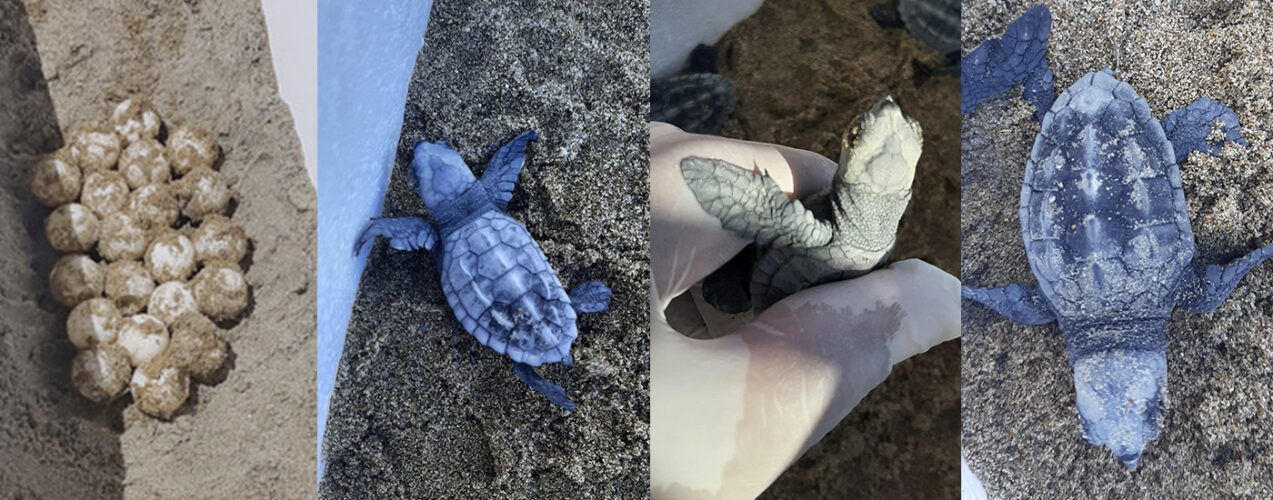The nesting of loggerhead turtles (caretta caretta) on Valencian beaches has been in the news this summer. It’s no wonder, since up to eight nests have been discovered on our beaches, which is a record high. And the nesting and subsequent hatching of the eggs has been one of the most beautiful spectacles that nature has offered this summer.
One of those moments was lived on August 27 on the Albaranas beach in Dénia. That night 72 caretta caretta turtles were born in one of the nests, and the eggs from a second nest are expected to hatch in the coming days. This moment came to be thanks to a fantastic team of collaborators that included the active participation of Campus Gandia of the Universitat Politècnica de València (UPV).
The Campus Gandia Campus (UPV) Research Professor Eduardo Belda explains that the InGeNi-Caretta project, which is carried out with the backing of the Biodiversity Foundation, has made it possible to monitor different specimens of loggerhead turtles, all of them females. To achieve this, satellite tagging was used with transmitters to help locate the specimens that have hatched on the Valencian beaches. Concretely, the monitored specimens had a radio transmitter installed in the shell, which did not exceed 1% of the animal’s weight and which allows them to be monitored for approximately a year and a half. This technology plays a fundamental role in locating nests, analyzing the behavior of these reptiles, which travel around 3,000 kilometers annually, and identifying the priority areas for their conservation due to their relevance for the reproduction and feeding of the species.

The team of collaborators in the Valencian Community was made up of the UPV, the University of Valencia researcher Jesús Tomás, and with the support of the Generalitat Valenciana and the Ministry for the Ecological Transition and the Demographic Challenge (MITECO). The work done by this team, alongside the participation of the public who notified 112 about the eggs laid in the located nests, has permitted the eggs laid in this nest by the turtle named Diana, to hatch undisturbed. 72 caretta caretta turtles that are already swimming in Mediterranean waters.
Captive breeding and satellite tracking for the preservation of loggerhead sea turtles
The efforts dedicated to the conservation of loggerhead sea turtles include notable recovery programs for injured individuals and captive breeding carried out by l’Oceanogràfic, as well as surveillance through satellites promoted by the Universitat Politècnica de València (UPV). Using the “Head Starting” technique, l’Oceanogràfic incubates a portion of the eggs from each nest and looks after the hatchlings for a year until they reach a weight of one kilogram and a shell length of 20 centimeters. The survival rate of newborns, with shells as small as 6 centimeters, is only one in a thousand. However, once they are one year old, their sole predators are sharks. Since 2014, l’Oceanogràfic has released a total of 177 turtles into the sea thanks to the Head Starting program. In addition, it is responsible for rehabilitating injured specimens collected by the Stranding Network. During 2022, medical care was provided to 110 turtles, and this year, 83 specimens have already been treated.
The InGeNi-Caretta satellite surveillance project is supported by the Biodiversity Foundation of the Ministry for the Ecological Transition and the Demographic Challenge (MITECO) within the framework of the Recovery, Transformation and Resilience Plan (PRTR), funded by the European Union – NextGenerationEU.

Source: Celia Marín Benito, Journalist for the Office of Communications at the UPV











